| ERIC CLAPTON and theMARSHALL STACKS |
| ERIC CLAPTON and theMARSHALL STACKS |
"Two 100-watt Marshalls. I set them full on everything, full treble, full bass and full presence, same with the controls on the guitar. If you've got the amp and guitar full, there is so much volume that you can get it 100 miles away and its going to feedback - the sustaining effect - and anywhere in the vicinity it's going to feedback." Eric Clapton, (Aug/Sept) 1967 (Rolling Stone, 1967).
"With Cream I always had two Marshalls set up to play through but I think it was just so I could have one as spare. I usually used only one 100-watt amp. I'd turn the amp and guitar all the way up." Eric Clapton, (early) 1970 (Guitar Player, June, 1970).
Of the two quotes above, the latter is the one that is now accepted as fact: "two stacks were typically set up on stage, but one was a spare." (Guitar Player, Jan 1999, p119). Which quote correctly describes what Clapton used?
THE SOUND OF ONE OR TWO STACKS? The amplification equipment is briefly described in instruments but the following is a more detailed analysis.Sound System Technology
What must be fundamentally understood is that Sound Reinforcement System, that are standard today, did not exist then (1966-68). It is these systems that now provide the venue (or stadium or festival) volume using microphones on the instrument speakers, drums etc. A bands whole sound is amplified and broadcast through it. It was not until 1969/70 that the technology was developed to enable that development, especially: low noise transistors, high power transistors, high sound pressure microphones and high efficiency/power handling speakers.
Cream relied on their instrument stacks, the drummers muscle power and a PA for vocals. The instruments were not amplified through the PA! This is clear from any concert photo - no mikes on speaker cabinets or drums (except when they were being recorded). The PA systems for vocals varied from the folded horns (movie theatre type) used at Fillmore/Winterland to the more common stacks of column PA cabinets (see Farewell Concert photos). The amplifiers used for the PA were low distortion valve amps slaved in parrallel with input from a very basic mixer, usually an amp with multiple input & volume controls.
The Marshall Stacks
In 1965, John Entwhistle began using an early 50 Watt Marshall head (JTM45 + 1984 cab) in place of his Vox. Townshend liked the attack (mainly a product of the KT66 valves and valve rectifier) and went to Marshall to get his own. In conjunction with John, he convinced Jim Marshall to up-rate it. By the end of '65 the 100 Watt was born but with a quite different sound as it used 6L6 valves and a solid state rectifier. To handle the power Pete and John got special cabinets built - single 8x12 (eight 12 inch speakers). Marshall realised that these were too unwieldy and split them into two (a flat and an angle) - the dual cab stack was born. It was immediately successful so in response Pete and John just doubled their rigs as they had to be louder than any other band!
When Cream formed in 1966, the stacks were de rigueur among the power bands. Eric upgraded from the 'Bluesbreaker' combo to a Marshall stack: Marshall 1959 100 watt Plexipanelled Superlead Amplifier (3 switch), 1 1960 75 watt 4x12 Angle Front Cabinet + 1 1960B 75 Watt 4x12 Flat Front Cabinet (extra tall version). This was set with…"full on everything, full treble, full bass and full presence" as this was the way he had set the combo. Volume and tonal variations were handled from the guitar controls.
Jack used the same setup but with different tone settings. They also used Marshall column PA (a pre-production 200W model) for the vocals. House PAs were pretty well unknown in the UK and it was always safer to rely on one's own equipment.
There was a notable change in Eric's sound. The Marshall 1959 did not give the thick sustain of the Combo but replaced it with a harder sound and the capacity to retain sustain and distortion effects at varying volumes, simply because it was so loud. The setting of the controls in such a way ensured the input and output stages of the amp were at maximum gain. Pete and Jimi invariably played with their guitar's volume on or near full to achieve maximum overload, however Eric took a cleaner approach. Eric used the low sensitivity flat 2nd input on the amp and backed off the guitar volume control just below that overload level. The result was a cleaner sound but still with the sustain he desired.
That early sound is well captured with "Spoonful" on 'Fresh Cream'. The 'Klooks Kleek' bootleg from 15th November 1966 is also enlightening. The amp is up high with volume being varied from song to song as appropriate. Eric's lead break on "Sweet Wine" is played at maximum volume with the overload clipping/overtones clearly evident. Most of the other songs are played at below this level, especially exemplified by "Crossroads" where his tone is sustained but not clipped.
All the photographic evidence is that they continued using single stacks well into 1967. Interestingly they used different combinations of cabs - there are photographs of Jack with two angles. This is probably the result of blowing speakers as the 1959 could generate up to 170 watts at Cream's overloaded volume levels and the cabs were only rated at 75 watts (& manufacturing tolerances were not what we know today). In 1967 the newer uprated speakers were almost definitely installed to give a more reliable 100 Watts a cabinet.
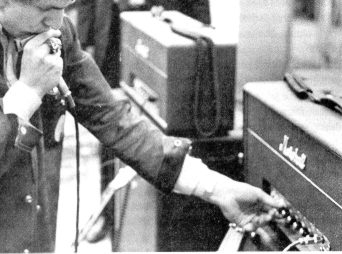 |
At the end of March, Cream headed to New York for the 'Murray the K - Music in the Fifth Dimension'. To keep costs down they only took their instruments as they were to use The Who's gear. Unfortunately The Who couldn't afford to take theirs and they had to borrow, beg and wheedle gear from the New York stores. And it was Vox as Chris Stamp had signed The Who to an "exclusive user of" contract.After the Murray the K show, Cream entered Atlantic studios. Don Paulsen's photographs from this session (April 3-4) show two 1959s each on a single cab (one flat [extra tall], one angle). These appear to be in 'as new' condition. It was not their working gear as concert photographs show tears in cabinet cloth and undoubtedly the amp cabinets would have also shown some wear. It is highly unlikely that they were shipped in from the UK for the hurriedly organised session, so I believe they had bought these in New York for the session - two heads and one stack. The US distributor was based in Long Island. |
Dual Stacks
On return to the UK they now had, at least, one extra stack and two 1959s. I believe they took the opportunity to up-rate to dual stacks to match The Who and out gun Hendrix. On 22nd April they were recorded at Ricky Tick in Hounslow, West London. At the start of "Sweet Wine" Eric says, "One of my amps has conked out, which is a total bring down…", Ginger - "We've got a spare one man", Eric replies "No, no we haven't got a spare one". There is now clear change in guitar sound as the remaining Marshall is cranked up - overload clipping/overtones. Now if that doesn't show that he was using a dual stack - what does? The bass is also very clear and present again strongly implying a dual stack and also clearly more present, relative to the guitar, after the breakdown.
There are photographs from other concerts after this date that show single stacks, but they were at 'package' concerts that invariably involved shared equipment to facilitate quick band changes. On one Jack is playing through a Sound City head & stack not his Marshall. The following is photo from a single cover is further evidence:
Probably: Germany, May 1967 (no earlier than April!) &
note the Les Paul 'Black Beauty" & painted bass.
(Courtesy Olli Oksala)
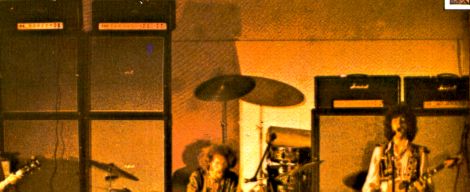
Cable connections between stacks (Fillmore, 1967)?
(Aug '99: new close up photo does show a cable between ECs amps!)
Cream had their double stacks and the photo on Live Cream Vol II clearly shows that both Eric's stack's are on, but he is only plugged into one amp and Jack's 2nd (the Super PA) is not on and it also is not interconnected. CORRECTION (Aug '99/may 2000) - I have now got a photo that does show a thin, taught cable connecting EC's amps (won't show on a scan) so based on this the above photo means nothing! Also Jack is only playing through one amp but that is a 200Watt model. So EC was playing the through dual stacks. They may very well have intended to just use singles, ie being conservative, but Bill Graham and the audience wanted "noise". Cream responded to such a degree that they "physically shook a lighting bridge free of its moorings." All reports are that they were the loudest band anyone had heard to that time! Also the first quote from Eric was from this time at the Fillmore and there is no reason to doubt what he says.
Why use two stacks? Well it was partly the battle of the loudest band but also a sound thing and it looked impressive. They needed to get louder to compete but also to maintain volume levels in the larger venues they were now playing. They had gone from venues holding a few hundreds, at best, to ones that held thousands. Turning up the 'wick' only created more overloading and harsh distortion. Two stacks allowed for more fine control of volume, tone and dynamics and as "there is so much volume that you can get it 100 miles away and its going to feedback - the sustaining effect." This especially applied to the 'SG' with its greater propensity for microphonic feedback. The bootlegs from the first US tour especially 'Brandeis' and 'The Grande Ballroom' show terrific volume levels but with controlled distortion, refined dynamics and spontaneous use of feedback.
More Evidence:
Olli Oksala on Cream's Nov '67 performance in Finland: "
One eyewitness sneaked to the soundcheck before the concert in Helsinki and he told me that Clapton used both Marshall stacks and he set everything on full and the sound was very loud in a 1300 seater concert hall."Eric changed his playing position - the photos from late '67 on show him standing well away from his stacks and close to the drums and bass. Presumably to hear the rest of the band, to escape from the direct 'noise' and provide better control over feedback ie a couple of steps back and the sound changes significantly. Pete and Jimi always played directly in front of their stacks to achieve their sound.
"Instead of having [just one] bass speaker and one guitar speaker either side of me, it suddenly grew into these huge double stacks. It got severely painful, and my pleas to turn it down were greeted with, 'No man, you're crazy' " - Ginger Baker.
From Café Au Go Go, September '67 - "They were playing loud enough for a baseball stadium" but through single stacks is a very small venue.
There are no statements from Jack or Ginger, to my and others knowledge, that support Eric's 2nd statement.
On 'Brandeis' bootleg as they go into the jam on "Toad", the guitar suddenly drops in volume, Eric starts doing fills while Jack takes lead. On the group end the guitar is still comparatively low. The concert closes, unusually without playing "I'm So Glad" - clearly one of the amps had failed.
The "Farewell Concert" photos and video show Eric and Jack plugged into both stacks, both on. Other photos and video show Eric twidling the knobs on both stacks.
Note: Y splitter cable and
|
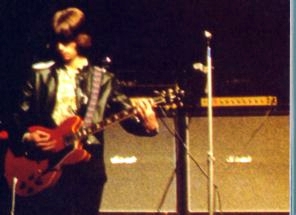 |
Jeff Aarons at his April '68 Cream concert confirm's that the "both amps power light was on and sound was coming from both stacks. Clapton changed settings on both amps". (Note: splitting the sound from one head over 4 cabs causes electronic problems that produces peculiar sound effects)
Eric's statement from 1970 is qualified in his own words - "I think". Eric would let the roadies decide such things? He was very obsessive about his guitars and sound - that’s what it was all about!!!!
Single or Dual Stacks?
Well that’s the case for, but life is more complicated than that!
On the photos for the March '68 performances in Those Were the Days - only Jacks left stack appears on and there is no inter-connection. Eric's are both on but again appear to not be interconnected (one on standby?).
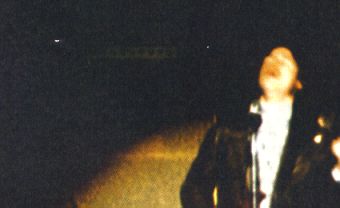 |
||
| Note: Cable to left stack no cable to right. |
Clearly on this no amp power light on right stack and no cable connection. These were taken at Winterland. EC's stacks did not scan clearly enough - check them on "Those Were The Days". However it is now (May 2000) known that Jack used a 200Watt amp. |
Light is probably a reflection, see middle photo |
Using double stacks requires a cable splitter from the guitar or a daisy chaining cable between the inputs of the amps (guitar plugs into the upper jack, a cable from the (parallel) input below into the upper jack on the 2nd amp[Jimi's generally preferred method]). Cream appears to have used some sort of splitter in '68 as the leads appear attached to something positioned on the top of the amps but on the final tour they used guitar cable splitters. In '67 they probably used the input/output type connection which, based on my rudimentary knowledge of electrics has impedance implications which can effect sound.
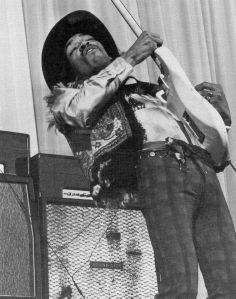 |
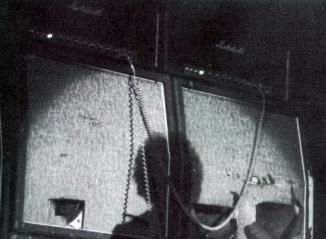 |
| Jimi using a Y splitter cable and note the right stack of Sound City Cabs with Marshall head (late '67) |
Jimi using the daisy chain technique (Nov. '68) |
| I believe they were only using the outer stacks. this was probably to keep volume down
for recording reducing bleed into drum mikes. is further reinforced on farewell tour:
Oakland bootleg contains calls from audience "turn it up" and of San Diego gig
(which was officially recorded) at which Jack's amp breaks down and there is a total
drop out sound. If double stacks were in use one amp would have continued as they
used cable splitters on this tour. Next complication - on the photo on Live Cream, the cable splitter is clear, the right amp 'Indicator' light is clearly glowing but where is the left? It's either not on or the light has blown. The latter is perfectly feasible and would not usually be repaired while on tour as keeping the sound side going was hard enough!. However they may have only been using single stacks. I believe that the stacks were adjusted based on the house PA. Depending on the power of the house PA they would use one or both stacks. Update - Aug, 99: I know believe this is unlikely as there is earwitness evidence from some concerts with bad or failing PA's that they just did minimal vocals and jammed. Clearly the Farewell Concert was good enough for both stacks. Jack's third stack was the spare set for quick swaps. As the final tour was in very large venues, use of both stacks would be logical and is supported by many earwitnesses. Eric's story may have been correct for some of the final tour - some audience bootlegs are bass dominant, indicating that Eric may have perversely used one stack on occasions, despite the huge venue. Update - Aug, 99: I know believe that this was the result of playing the Firebird which wouldn't drive the stacks to maximum output while Jack played turned up flatout. However experienced ear witnesses at some very large venues describe his overwhelming volume. |
 |
Conclusion
Both quotes are correct. When playing with dual stacks - one is naturally a spare whether you are playing through both or just one. They did use both stacks and often, just one each, to balance up against the vocals PA*. If they went to two they could easily control the volume via the guitars. Really it was the best they could do with the available technology. And remember Baker was still relying on muscle power!
* The same applies to The Who, all the photos I have seen of the '66 dual stacks in concert show no interconnection. They looked great though! But in 1967 - oh yeah!
More Photos (there are plenty of good photo's of Jimi's setups, alas not Cream):
 |
| Daisy Chain cabling setup. This how Hendrix and Townshend used it. They plugged into input 1 which is the "High Treble" input. Input two is the normal or "flat' input which is the one Clapton (and Bruce) used. Interestingly the original production 1959 Superleads of 66-67 had two flat inputs. The "High Treble" input, which was standard on the preceding Bluesbreaker combo and JTM 45 head, was introduced in late '67. I believe that all three had the amps customised to include that additional curcuitry (additional resistor and capacitor). The high treble input had a rising treble response and higher sensitivity. Clearly Eric didn't like this effect and it was not appropriate for a bass guitar. |
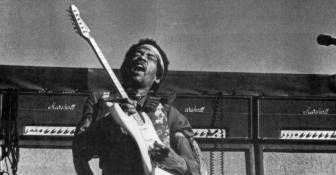 |
On this the guitar lead appears to be plugged into something on top of the middle stack. This is presumably a splitter that then links into all three amps. It appears that Cream on early '68 tour used such a device. The cables appear to go to the top of the amps as well (very hard to see on the photos with a magnifying glass so not visible on any scanned photos). |
| Jimi's Woodstock rig - Y splitter with the 3rd stack being daisy chained off the left stack | 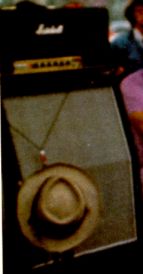 |
© Graeme Pattingale, 2000 (Updated/corrected Aug 1999, May 2000)